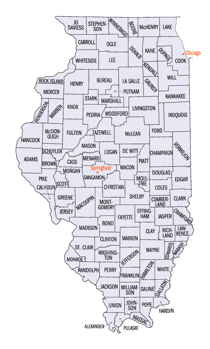Illinois Counties
There are one hundred and two counties in Illinois. St. Clair County was the first county established in what is today Illinois. Most counties in Illinois were named after early American leaders, especially of the American Revolutionary War, as well as soldiers from the Battle of Tippecanoe and the War of 1812.Christian County, Illinois
Christian County Education, Geography, and History
Christian County is a county located in the state of Illinois. Based on the 2010 census, the
population was 34,800. Christian County was
created on February 15, 1839. The county
seat is
Taylorville. The county is named for Christian County,
Kentucky, which was itself named after Colonel William Christian.
Christian Count comprises the Taylorville, IL Micropolitan Statistical Area, which is also included in the Springfield-Jacksonville-Lincoln,
IL Combined Statistical Area.
Etymology - Origin of Christian County Name
The name first given to it was Dane, in honor of Nathan Dane, one of the framers of the Ordinance of 1787, but a political prejudice led to a change. A preponderance of early settlers having come from Christian County, KY., this name was finally adopted.
Demographics:
County QuickFacts: CensusBureau Quick Facts
Christian County History
Christian County was created on February 15, 1839 as Dane County (Laws, 1839, p. 104), Name changed to Christian
County in 1840 and was formed from Montgomery, Sangamon and Shelby Counties. Present area, or parts of it, formerly
included in: Sangamon County (1821-1839), Shelby County (1827-1839), Montgomery County (1821-1839), Fayette County
(1821-1827), Clark County (1819-1821), Bond County (1817-1821), Crawford County (1816-1819), Madison County (1812-1817),
Edwards County (1815-1816), St. Clair County (1790-1812) and Knox, Northwest Territory (1790-1801).
The County was named for Christian County in Kentucky through the influence of emigrants from that county and for Colonel
William Christian, a native of Augusta County, Virginia, and a veteran of the Revolutionary War, killed by Native
Americans in southern Indiana in 1786. The County Seat is Taylorville (1839-Present).
Geography: Land and Water
As reported by the Census Bureau, the county has a total area of 716 square miles (1,854 km2), of which 709
square miles (1,836 km2) is land and 7 square miles (17 km2) (0.93%) is water.
Christian county is located close to the center of Illinois. The county is a fertile agricultural county, lying in the "central belt" and organized in 1839 from parts of Macon, Montgomery, Sangamon and Shelby Counties. The land is level and the soil fertile, the northern half of the county being best adapted to corn and the southern to wheat.
Neighboring Counties
Bordering counties are as follows:
- Northeast: Macon County
- Southeast: Shelby County
- Southwest: Montgomery County
- Northwest: Sangamon County







